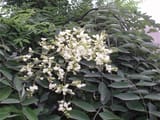Search Results
7/2/2025, 4:33:02 AM
>>212329898
It was never really completely dropped, it was just a way of phrasing that become less and less common over time.
It appears over and over again in the 万葉集, but in later poem anthologies it might appear in only one poem, and often times they're older poems that were also included in the 万葉集. For example, in the 古今集, you have:
>さ夜なかと 夜はふけぬらし かりがねの
>きこゆるそらに 月わたる見ゆ
which is also 1701 in the 万葉集:
>佐宵中等 夜者深去良斯 鴈音
>所聞空 月渡見
and in the 拾遺集 you have:
>そらの海に 雲の浪たち 月の舟
>星の林に こぎかくる見ゆ
which is 万葉集 1068:
>天海丹 雲之波立 月船
>星之林丹 榜隠所見
this 見ゆ always appears at the end of a sentence and has a meaning like "..., I see" or "... is visible," rather than the meaning "has the appearance of..." or "seems like..." that you get from と見ゆ or と見る, which is much more common, like:
>たつたひめ かざしの玉の ををよわみ
>みだれにけりと みゆるしら露
in this case, the dew is not actually a set of jewels on a string that breaks, the author is just saying it "appears" that way, whereas in the two examples above the author is directly stating that he "sees the moon crossing the sky" or "sees the moon making its way (like a boat through the sky) into the stars where it hides (as if they were trees)."
older poems with this structure continue to appear into the 1300s, and very rarely they're ones that don't also appear in the 万葉集, but usually they're clearly influenced by phrasing from the 万葉集, like from the 新後撰集:
>山人の 炭焼くならし 雪ふかき
>とほつ小野辺に 煙立つ見ゆ
the same "けぶりたつみゆ" is found in 万葉集 1879, but in a different poem:
>春日野尓 煙立所見 女嬬等四
>春野之菟芽子 採而煮良思文
the とほつ for とほし, 遠い is also a clearly archaic phrasing that's rarer in later poems, suggesting that the author is invoking an older register or even that this is another pre-classical poem simply not included in the 万葉集
(random image to bypass character limit)
It was never really completely dropped, it was just a way of phrasing that become less and less common over time.
It appears over and over again in the 万葉集, but in later poem anthologies it might appear in only one poem, and often times they're older poems that were also included in the 万葉集. For example, in the 古今集, you have:
>さ夜なかと 夜はふけぬらし かりがねの
>きこゆるそらに 月わたる見ゆ
which is also 1701 in the 万葉集:
>佐宵中等 夜者深去良斯 鴈音
>所聞空 月渡見
and in the 拾遺集 you have:
>そらの海に 雲の浪たち 月の舟
>星の林に こぎかくる見ゆ
which is 万葉集 1068:
>天海丹 雲之波立 月船
>星之林丹 榜隠所見
this 見ゆ always appears at the end of a sentence and has a meaning like "..., I see" or "... is visible," rather than the meaning "has the appearance of..." or "seems like..." that you get from と見ゆ or と見る, which is much more common, like:
>たつたひめ かざしの玉の ををよわみ
>みだれにけりと みゆるしら露
in this case, the dew is not actually a set of jewels on a string that breaks, the author is just saying it "appears" that way, whereas in the two examples above the author is directly stating that he "sees the moon crossing the sky" or "sees the moon making its way (like a boat through the sky) into the stars where it hides (as if they were trees)."
older poems with this structure continue to appear into the 1300s, and very rarely they're ones that don't also appear in the 万葉集, but usually they're clearly influenced by phrasing from the 万葉集, like from the 新後撰集:
>山人の 炭焼くならし 雪ふかき
>とほつ小野辺に 煙立つ見ゆ
the same "けぶりたつみゆ" is found in 万葉集 1879, but in a different poem:
>春日野尓 煙立所見 女嬬等四
>春野之菟芽子 採而煮良思文
the とほつ for とほし, 遠い is also a clearly archaic phrasing that's rarer in later poems, suggesting that the author is invoking an older register or even that this is another pre-classical poem simply not included in the 万葉集
(random image to bypass character limit)
Page 1
